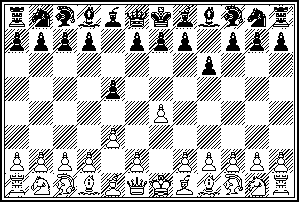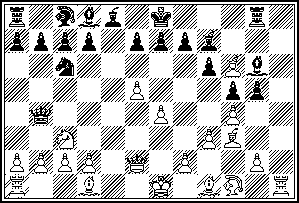Variant Chess Index
|
The magazine to broaden your chess horizons
|
Contents
|
Philatelic Variants - by David Pritchard The first postage stamps to feature chess were a set of three issued by the U.S.S.R. in 1948 to celebrate the World Chess Championship in Moscow of that year. Since then, over a hundred countries have produced stamps with chess as the central theme - including Great Britain: the 11p value of 1976 depicts a woodcut from Caxton's The Game and Playe of Chesse. The first stamp to feature a variant (xiangqi) was issued by China in 1955 with another design in 1959. Xiangqi was also the the subject of stamps from Taiwan (1984 and 1994) and, curiously, St. Vincent (1994) which shows two women playing the game. Changgi (Korean chess) was illustrated on a stamp of South Korea (1985) and another from North Korea (1995). Other variants to have appeared on stamps are shogi (Japan 1994) and the Courier game (Paraguay 1978). The 27 peseta stamp of Spain issued in 1992 shows Great Chess from Alfonso X's Book of Chess. Handsomely produced sets featuring the Alfonso book have been issued by a number of countries: the Yemen (1967), Hungary (1974), Nicaragua (1975), Paraguay (1978), Laos (1984) and Afghanistan (1989). Designs have included Shatranj and Great Chess. It must be admitted that, with the exception of Hungary, these countries have in the past marketed many stamps aimed at the collector's market with the aim of raising revenue, and are not treated seriously by philatelists. Chess pieces, rather than chess games, have appeared on stamps of many countries. Some of the pieces can be linked to early variants. A stamp from Vietnam depicts a 16th century king and rook from sittuyin (Burmese chess) whilst other stamps in the same series include an early Russian rook (boat) and a king from India (elephant). |
||||||||||||||||||||||||||||||||||||||||||||||||
|
Modern Courier Chess by Paul Byway For this article, and for the first time, I have synthesised a more or less satisfactory diagram font for Modern Courier Chess. I use the freeware True Type fonts designed by Armando H. Marroquin and available from the web site of the Nørresundby Chess Club (well worth a look!). The basic font is Chess Adventurer, with additions from Chess Leipzig (rook and bishop) and Chess Condal (courier).
White: Paul Byway Black: Roy Talbot
1. g2-g4 e7-e5
2. e2-e3 i7-i6
White intends to occupy the centre and 'hope that something will turn up'. Black's moves are individually good, but at the moment I don't see how to combine them in a coherent plan of development. 3. f2-f4 e5xf4
4. e3xf4 j7-j5
5. Nb1-c3 k7-k5
6. l2-l4 Fh8-j6
I think Black should have played ...k5-k4 - but then, perhaps White shouldn't have played l2-l4. 7. l4xk5 Fj6xk5
8. Nk1-l3 Fk5-j6
9. j2-j4 Cj8-l6
10. i2-i3 Nk8-i7
11. Cc1-e3 Rl8-k8
12. Fh1-j3 Nb8-c6
13. Fe1-g3 Cc8-e6?
|
The biggest difference in the positions here is White's pair of central pawns, and now he intends to cash in. 14. f4-f5 Ce6-c8
15. Fg3-h4 Bi8-k6
16. Ce3-g5 Qf8-c5+
17. Qf1-f2 Qc5-b4
Things are not going well for Black. He lost two tempi and then made a poor bishop move, which had the unfortunate side effect of taking the knight's last escape square. When White wins it for a courier he will have a small material advantage. In addition the White queen has come, without loss of tempo, on to the same diagonal as the fers at h4 - with effects that will soon be seen. 18. Cg5xi7 Fj6xi7
19. Nl3-k5 Cl6-j6
20. Fh4-i5 l7-l6
21. Fi5xj6 l6xk5
|
|
Modern Courier Chess
22. Fj6xi7 i6-i5 The diagonal march of the fers has generated significant threats. Here, instead of the pseudo-active ...i5, Black should cut his losses with ...Qd4. 23. Qf2xi5 Qb4-d4+
24. Kg1-h1 Qd4xd2
25. Rl1-l8 Rk8-i8
26. Rl8xi8+ Bk6xi8
27. Fi7-h6 g7xh6
28. Qi5xi8+ Kg8-g7
Complete destruction of the kingside. It's time to bring up the reserves. 29. Cj1-h3 Qd2-e1+
30. Kh1-i2 k5-k4
31. Ch3xj5 k4xj3+
32. k2xj3 Qe1-k7
33. Bi1-l4! f7-f6
34. Qi8-h8+ Kg7-f7
35. Nc3-d5 Qk7-k2+
36. Bl4-j2 Resigns
The game contains plenty of errors. Nevertheless, we can learn quite a lot from it. (i) In the opening 1.g4 e5 2.e3 looks like a reasonable sequence (control of h5!); maybe Black should try 2. ...f5. Alternatively 1. ...i5 and 2. ...j6 could be tried; the black bishop has two good diagonals and can be supported on j7 by ...Nl6. (ii) The central pawn pair retains its power in MCC. Whether there is enough counterplay to one side or the other of it remains an open question. (iii) There's a good example of the St. George attack (a line piece supports and propels a single-stepper) disrupting the opponent's position. Almost always seen in chess in the form of a rook supporting an advancing pawn. |
|







